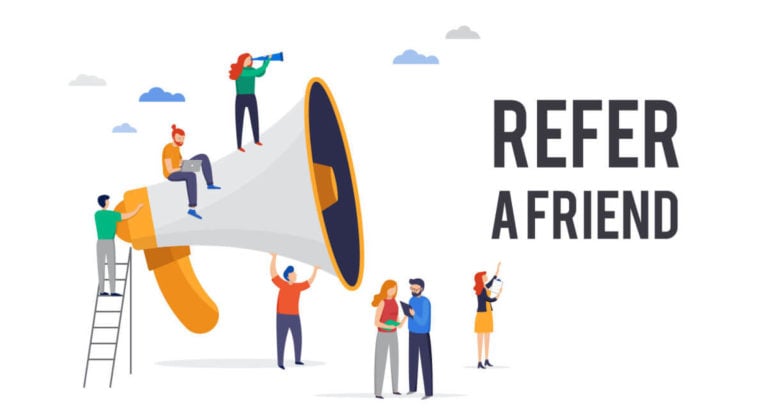Organizations are always looking for skilled, reliable talent. There are plenty of ways to find new work candidates—such as recruiters, job boards, networking events, and job fairs. However, you don’t want to leave one of the most effective recruitment methods on the table: your own workers.
Chances are your team knows friends and family who may have the very skills you’re looking for. They may be socializing with people in the same industry or may have gone to school with workers in the same sector. Your employees may have worked with talented people in past positions and they may still be in touch.
Creating a system for tapping into these potential workers can help you make your next hire! Read on to find out how to create a robust employee referral program and to find out more about how such a program can make a difference.
What Is an Employee Referral Program?
An employee referral program is a type of internal recruitment. It allows you to tap into the network of potential employees your existing team may know. It’s a process for getting your employees to recommend their friends, acquaintances, and family for your open positions, so you can hire internally.
What Are the Main Benefits of an Employee Referral Program?
An employee referral program has specific benefits over other forms of recruitment.
You’re pre-vetting talent
When employees refer their acquaintances, they likely know something about the skills of these potential candidates. You can even ask your workers about the strengths of weaknesses of the people they are recommending.
Candidates referred by someone else may be more likely to stay
Turnover costs for just one employee can add up to between 25% to 200% of an employee’s salary. Keeping turnover costs low is an important part of staying cost-efficient at your organization.
One study by iCIMS found that referral hires stay 70% longer when compared with employees hired through other types of recruitment. As well as this, the employees making the referrals stay 20% longer than non-referring workers.
You may be tapping into a hidden job market
Some individuals are looking for work openly. Other workers may already have positions but could be open to changing companies. It is harder to find these in-demand employees.
Your own team, however, may know who is looking for work and can help connect you. Your workers can help put you in touch with candidates you might not be able to reach through job boards or any other way.
It’s a cost-effective recruitment system
Research from the Society for Human Resource Management (SHRM) shows that the cost of the average new hire is close to $4,700. In some cases, it can be higher.
It can all add up quickly if you’re having to pay for job board ads, recruiters, and so on. With an employee referral system, you can ask your teams for recommendations and potentially reduce some of the costs of finding candidates.
You may reduce the amount of time and effort needed to hire
If you’re hiring through job ads, recruiters, or other traditional methods, you may get hundreds or even thousands of applications. Some of them may be very unsuited for the role, but you still need to review all of them and reply.
When you use an employee referral program, you get a smaller number of more appropriate candidates. This smaller pool can make it easier to review your options and hire more quickly. Even onboarding can be more streamlined if a new hire has a friend or family member in the workplace who can catch them up.
How Can I Build a Strong Employee Referral Program?
It’s not as simple as asking your workers to recommend friends and family. You want your teams to suggest the most appropriate candidates. Here’s how to do that.

Communicate with your team
You’ll need to connect with current employees to let them know that you’re hiring and looking for recommendations. You can do this through email or even send out notifications through an app like Connecteam chat. This helps to let all your workers know you would appreciate their suggestions. You can also use an internal job board to make it easier for workers to see what positions are open.
Be clear about your expectations
Create a clear job description for the role you’re hiring for. Outline exactly what you’re looking for, and what you’re not looking for. You can store these job descriptions on a platform like Connecteam’s knowledge base and even encourage employees to share these job descriptions with people they know.
Make it easy for workers to make referrals
You don’t want your employees to have to fill out a ton of paperwork to refer someone. Make it easy for them to send you a name and contact information through informal communication or to post your job ads through their social media. If it takes just a few clicks or a short message, it’s more likely someone will take time out of their day to share a recommendation.
Consider incentives
Many companies reward their employees for helping with recruitment. Some referral programs have cash bonuses if someone refers a candidate. The employee making the referral may get hundreds or even thousands of dollars as a bonus—depending on the company and the position to be filled.
You can even choose to offer staggered bonuses. This would involve paying a bonus at different stages of the process—e.g., a bonus for the referral, a bonus if the referral is hired, and then a bonus if the referral stays for at least six months. This can encourage workers to carefully consider and recommend high-quality candidates.
In addition to cash bonuses and incentives, you might want to consider non-cash incentives too. Non-cash incentives and rewards can be used alone or with cash bonuses. They add a layer of reward to the recruitment process. For some workers, something fun—like a trip—may be more of an incentive than money.
Connecteam’s employee recognition and rewards app lets you instantly reward and recognize workers who go above and beyond. You can use the platform to say “thank you” to anyone on your team who is referring great candidates.
Review your application system
If you’re going to be getting recommendations for new team members, take a look at how these referred candidates will apply for a job. Will you be reaching out to these candidates directly? Will you be sending them to an online application page? Will recommendations have access to internal job postings like the rest of your team?
Consider how you want candidates to go through the application process. At a minimum, you will want to keep employee referral candidates separate from other candidates so you can look more closely at these applicants. If they’re applying through a public-facing online application form—for example—make sure they can indicate they were recommended by a worker at your company.
Look at your application process end-to-end. Is it simple and intuitive? Does it get you all the information you need to make a hiring choice without adding unneeded steps for the applicant?
Is the process relatively pleasant for the applicant? You want recommended workers to move through the process easily, without abandoning mid-way because of bugs or other problems.
Keep track of metrics
Once you’ve set up a referral program, make sure you keep track of how many employees take part. It’s also important to track how many recommendations you’re getting, and how many recommendations lead to hires. You might even want to keep an eye on how many recommended workers stay on past six months and/ or a year.
Keeping track of data like this helps you evaluate the effectiveness of your program. If you’re not getting many recommendations, your program could use more internal advertising or maybe different incentives. If you’re getting recommendations—but they’re not leading to high-quality hires—maybe you need to be clearer about what you are seeking in candidates.
Provide updates
When workers refer someone they know, they may naturally be curious about whether their suggestion will be accepted. Provide as much detail as you can about the application process to your employee. While you want to let the candidate know about decisions first, you will also want to let your employee know about your decision too. Keeping communication open makes your workers feel involved in the process and lets them feel acknowledged for their recommendations.
If you don’t choose a candidate that has been suggested by someone on your team, send your worker a thank-you note anyway. Encourage them to keep making recommendations if they know anyone who would be a good fit for an open role.
Know who’s making successful referrals
Some workers may have a larger network and may be able to refer more quality candidates. Others may have a better sense of what you’re looking for and may consistently make suggestions that lead to strong hires.
Either way, if you have a few workers who are helping you find great talent, offer extra incentives and rewards. You may want to offer a shout-out on social media, name the worker as an “employee of the month,” or have the Chief Executive Officer (CEO) send them a personal note. Showing your appreciation helps your most effective internal recruiters keep up the good work.
Build your own robust employee referral program by easily communicating with your employees and managing onboarding, documents, and more with Connecteam.
Examples of Strong Employee Referral Programs to Inspire You
Let’s look at some examples, so you can see what other organizations have gotten right and build your own employee referral program template.
Google—not surprisingly—has a robust referral program. Notably, Google had struggled to get worker referrals—even after it had doubled its referral bonus to $4000. Instead, the company found it had better results when it asked “Who is the best person you know for this specific role?”
Google also had employees work with recruiters in the same room, looking at candidate profiles. This gave workers a real-time look at the vetting process and gave them instant gratification in seeing which job seekers were chosen.
The software company Katalon has a very transparent referral program. It even includes the fine print online, so you can see exactly how its employee referral program template is set up.
Workers get a bonus if their referral leads to a hire. The cash amount is higher if the new worker is onboarded and stays at the company. The bonus is also larger for more senior positions.
Salesforce once had to fill multiple positions for their team. They invited a group of recommended candidates to an in-person happy hour, where they could meet Salesforce employees. Hiring staff had a chance to talk to talent in a relaxed atmosphere.
Afterward, the most promising candidates were invited to recruiting workshops, where they learned more about the company and took part in challenges. At the end of the workshop, hiring teams had a clear picture of who they wanted to hire.
In 2015, InMobi was able to get referral hires to increase from 20% to 50%, all by taking away cash bonuses. Instead, the company parked a Royal Enfield bike in its India office and a Vespa in its US location. The company explained that whoever made a successful referral could choose between a bike or a trip.
Harnessing the Power of Your Team with an Employee Referral Program
Your current workers may just know someone who’d be perfect for your next hire. Setting up a referral system requires strong communication, clarity, and carefully considered incentives.
The payoff can be more than worth it. Relying on your internal network has plenty of benefits—including better quality candidates, time and cost savings on recruitment, and new candidates who tend to stay longer in their roles.
If you’re looking to manage an internal referral program, Connecteam can help.
Connecteam offers a knowledge base, employee communications systems, and other value-added features that help you manage employees, tasks, onboarding, hiring, and more.
Started Your Own Employee Referral Program Today with Connecteam
Communicate with employees, conduct surveys, send incentives, onboard, schedule, and so much more.




